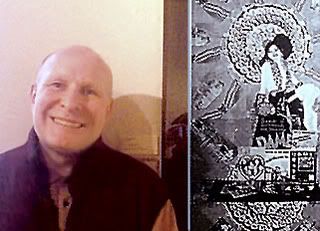Been awhile -- been busy!
Weather: First snowfall over this weekend. We are supposed to be getting a new roof -- hmmmm.
Wildlife: Bald Eagle hunting over Middle Foy's Lake. Snow Goose migrating with the Canadian Honkers. Huge rooster Pheasants grazing in the front and back yards.
Charity Alert: The Animal Rescue Site : Feed an Animal in Need
The One Book Montana Project:
Some Thoughts on James Welch's Fools Crow
By Michael Evans (mevans@fvcc.edu)
My apologies for having another appointment this evening, but I wanted to contribute a little something to the "One Book Montana" discussion anyway, so I'm writing down a few impressions from my reading of Fool's Crow.
(I was having FUN! I saw Repertory Dance Theater on tour that night and met my ol' friend Linda C. Smith again. Repertory Dance Theatre)
While dealing with the first chapter I realized that I would have to identify people and places by names which were short phrases instead of proper nouns. I was skeptical, but got used to the trick well enough to employ it as an aid to accepting a story about 1870's Montana from the point of view of the Blackfeet (Pikuni), as personified in the protagonist, White Man's Dog/Fools Crow.
Welch was immediately successful in depicting his Lone Eaters band of Pikuni as human beings, with their own recognizable needs and desires, and a particular way of life that unfolded in the first of many journeys in the book. By the end of this initial journey, our young, ill-favored protagonist establishes himself within the hierarchy of his band. It is an archetypical tale, with antecedents in many cultures, and his progress in taking on the responsibilities of manhood with attendant joys and disappointments is well-structured.
Since the Blackfeet were hunters and gatherers, the many journeys of Welch's characters are a reasonable method of painting the scenes in which the historical, fictional, and even fantastic action takes place. Welch's word-painting resembles watercolors done with broad brushstrokes -- there are a few key details, but the work derives its overall color from a limited palette, and distant impressions, rather than clear portraits, seem to characterize this novel for me.
To Welch's credit, he did not impose too much obvious meaning onto his narraratives. My forbearers, the Napikwans, or white men, are pictured as ruthless, violent, pushy, and uncaring -- indeed, many Whites behaved in those ways towards native people, especially after the Civil War. Fools Crow's band, as buffalo hunters, would be doomed to conflict with ranchers and town-builders. Other Blackfeet coped with traders from the east to some extent, but this book tells little about them.
Native Americans from other nations are named largely by insults, and they are either targets of the Blackfeet's mischief or wrath. The initial defining episodes of the book involve two attacks on the Crow tribe in central Montana. The first raid, where our protagonist wins patriarchal acceptance by the Lone Eaters, involves the theft of a substantial herd of horses, and the murder of hapless Crow guards. Cruel, but somewhat understandable retribution by the Crow's chief, considering losses which threaten his people's well-being, provokes a bigger attack by a confederation of Blackfeet bands, whereby White Man's Dog earns the name Fools Crow in battle. The ruinous stupidity of such gang-like behavior, while ignoring the threat of foreign invaders, who are hostile to everything the native people know, is left up to the reader to perceive.
The fragility of the Plains Indian's way of life is brought into relief during one of our protagonist's early journeys, while he's visiting the remnants of Little Dog's band -- a chief assassinated by his own people for being over-accommodating to the demands of U.S. soldiers.
Look around you...do you see many of our young men? No, they are off hunting for themselves, or drunk with the white men's water, or stealing their horses. They do not bring anything back to their people. There is no center here. That's why we have become such a pitiful sight to you.
Welch does not mention the fact that horses and guns were fairly recent additions to the lives of native people on the Great Plains. These tools made living off of buffalo herds much easier, but they were not as traditional as the context of the book might make them appear. The possession of them exacerbated rivalry and warfare, and the desire for more of them became ends in themselves. I personally believe that the free-roaming buffalo would have become extinct in another generation or two, without the extreme hastening effects of the railroad, and westward expansion of European immigrants -- who supplied guns and horses in the first place.
Fools Crow's resolution is only implied -- surrender to the power of the encroaching Whites, with survival of the Blackfeet's children as a tangible, but ill-defined goal. It is masked in spiritual visions, and awkward accommodating speech. Resignation to this degree must have been a painful experience to all members of a once-independent people, but their livelihood was outright doomed. How they survived the terrors of starvation, disease, and continuing hostility (disguised as neglect) by U. S. authorities is another subject, though.
In the Community: Real mellow opening reception at the Hockaday -- Hockaday Museum of Art - Prime visual arts resource in Flathead Valley of Northwest Montana.
More to tell later -- for now, read about this fine organization: The Working Group
Tuesday, October 19, 2004
Subscribe to:
Comments (Atom)
